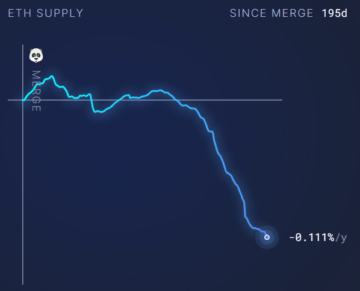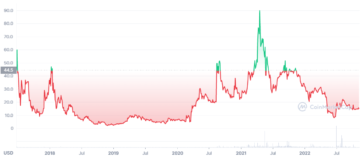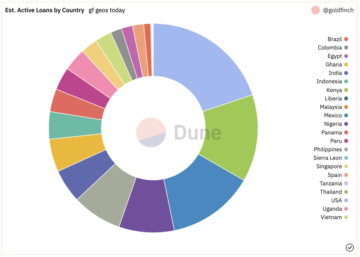As Ethereum cultivated its ecosystem of decentralized applications (dApps) in recent years, Solana popped up on the blockchain scene and became one of its top challengers.
Developed as an ultra-fast and scalable network, Solana is often called a third-generation blockchain, with Bitcoin representing the first and Ethereum representing the second one.
Here’s a primer on how Solana works:
The Problem With Decentralized Blockchains
Ethereum and Solana are public blockchain networks that support smart contracts to replicate traditional financial services: loans, exchanges, marketplaces, predictive markets, derivatives, and other offerings.
They use a network of nodes. When users access those smart contracts embedded into data blocks, each node (a computer running software) verifies the transaction and adds it to the blockchain. This creates a public and decentralized ledger that everyone can verify without permission.
Nonetheless, that verification process creates two problems:
- A speed bump that makes people wait for simple transactions to execute (on Ethereum from 13sec to 5min)
- Volatile transfer fees, which may go up over $100 for simple coin transfers, or go under a dollar, depending on the user traffic that day.
Traditional payment networks such as Visa don’t have to worry about these problems because they are neither decentralized nor permissionless. This allows high network throughput and Visa executes up to 65,000 transactions per second vs. Ethereum’s 15 tps.
Solana’s Origin and Purpose
Ethereum may have blazed the trail for decentralized finance (DeFi), but it was not suited for mass scaling. That created an opportunity for a new blockchain network. . This is where Solana comes in with its Visa-level performance of up to 50,000 tps.
Anatoly Yakovenko and Raj Gokal launched the Solana project in 2017. Together with Greg Fitzgerald and Eric Williams, they embarked on a mission to solve the low throughput problem on public blockchain networks through Solana Labs, headquartered in San Francisco.
This is an important distinction to make because private blockchains can have enterprise-grade performance. After all, the network owner decides how many nodes there are, which limits the node verification speed bump. With public blockchains, this is not the case, as they are permissionless.
Since 2017, Solana Labs tapped software developers from Microsoft, Google, Qualcomm, and other tech giants to build its project. Through nine founding rounds, Solana has raised almost $336M, from venture capital firms, including Tor Kenz Capital, Alameda Research, Blockchange Ventures, and Multicoin Capital.
Solana’s mainnet went live in March 2020.
How Does Solana Address Network Throughput?
Not all public blockchain networks have the same utility. Bitcoin’s network, for instance, is very limited in its scope, only providing smart contracts that record coin allocation. As such, the network is not used nearly as much as one that hosts DeFi dApps, which are typically used on a daily basis.
You can see this when comparing daily transactions of Bitcoin vs. Ethereum.
Moreover, Bitcoin relies on Lightning Network as its Layer 2 scalability solution to process instant payments in stores. Similarly, Ethereum relies on Polygon, Arbitrum, Optimism, and other L2 networks to do the same.
Solana bypasses that patchworked approach and relies on the scalability of its main chain, called Layer 1. For this reason, Solana is considered a third-generation blockchain. How does it accomplish this? First of all, Solana uses a Proof-of-Stake (PoS) consensus mechanism to validate transactions.
[embedded content]
Unlike Bitcoin, which uses Proof-of-Work (PoW), PoS blockchains inherently offer greater scalability because they replace energy-hungry computational work with economic stakes. That means validators replace miners, using their token holdings — stakes — as qualification to participate in the network’s security.
Solana has three key design innovations:
- Proof-of-history (PoH): In addition to PoS, Solana uses PoH. This is a pre-consensus time-stamping protocol that establishes a chronological timeline across all added data blocks (transactions). Consequently, network nodes don’t have to wait for other blocks to be added, which significantly reduces transaction overhead. In turn, this increases network throughput.
- Tower BFT: Working in tandem with PoH, Practical Byzantine Fault Toleration (PBFT) reduced the network’s latency further by achieving consensus sooner.
- Turbine: Essentially, the implementation of sharding, Turbine protocol breaks data into smaller bits, creating smaller node collections (neighborhoods). This spreads the transaction settlement load, increasing the network’s capacity to handle traffic.
Ethereum is scheduled to use sharding in The Surge phase, which is to come after The Merge in September 2022, when Ethereum becomes a PoS blockchain. In addition to these three features, Solana uses other techniques to get the performance edge: Gulf Stream, Sealevel, Pipeline, Cloudbreak, and Archivers.
Without going into nitty-gritty detail that requires advanced math and cryptography, they are optimizing the network, so there are few bottlenecks to be found at any point of Solana’s architecture.
Solana Tokenomics
SOL is Solana’s native token, launched at 500M SOL, out of which 66% is in circulating supply. Based in Geneva, Solana Foundation manages SOL distribution and Solana development.
For instance, in May 2020, Solana Foundation permanently burned 11.4M SOL to “account for market-making activity.” Theoretically, this means that Solana has an unlimited supply. Since its mainnet came online, the total supply increased to 527M, making SOL an inflationary cryptocurrency.
Solana does reduce its supply during these planned token reduction events. Moreover, half of each transaction fee is burned, with the remainder going to validators for processing transactions. Solana is moderately decentralized, composed of 1,930 validators and 1515 RPC (Remote Procedure Call) nodes.
Validators typically receive ~6.5% APY (annual percentage yield) as rewards. Validators use Phantom wallet to receive staking yields and access Solana’s ecosystem of dApps. Other popular Solana wallets are Solflare and Sollet.
Solana Outages Explained
What use is a network if it goes down often? After all, Solana may outperform Ethereum by 200 times in tps, but when it’s down, the speed is zero. It seems that Solana suffers outages every month. In contrast, Ethereum’s worst-case scenarios are typically prohibitive gas fees during high traffic.
In 2021 and 2022, Solana went down at least seven times. Solana’s co-founder Yakovenko tends to attribute these downtimes to “excessive transactions,” resulting in duplicate transactions that overload the network’s capacity. Whatever the technical trouble may be, it doesn’t bode well for Solana’s mission to scale up globally.
To tackle the outage issue, Solana partnered with blockchain infrastructure developer Jump Crypto, which is a part of the Chicago-based Jump Trading Group conglomerate. The goal is to build a new validator client to increase the network’s throughput capacity.
Previously, in October 2021, Jump Crypto connected Solana’s Wormhole bridge to the now-collapsed Terra (LUNA) blockchain. Solving this infrastructural challenge is a major task for Solana.
Not only is Ethereum proceeding with its scalability upgrades, but Cardano, Avalanche, Near, and other blockchains are making inroad in the third-generation DeFi market.
Series Disclaimer:
This series article is intended for general guidance and information purposes only for beginners participating in cryptocurrencies and DeFi. The contents of this article are not to be construed as legal, business, investment, or tax advice. You should consult with your advisors for all legal, business, investment, and tax implications and advice. The Defiant is not responsible for any lost funds. Please use your best judgment and practice due diligence before interacting with smart contracts.
- Bitcoin
- blockchain
- blockchain compliance
- blockchain conference
- coinbase
- coingenius
- Consensus
- crypto conference
- crypto mining
- cryptocurrency
- decentralized
- DeFi
- Digital Assets
- ethereum
- machine learning
- non fungible token
- plato
- plato ai
- Plato Data Intelligence
- Platoblockchain
- PlatoData
- platogaming
- Polygon
- proof of stake
- The Defiant
- W3
- zephyrnet











